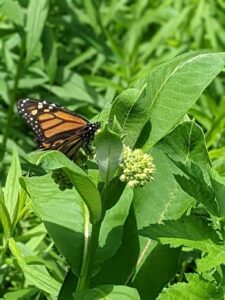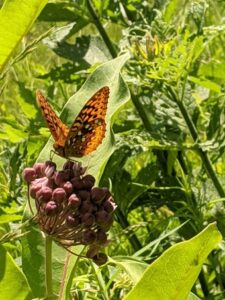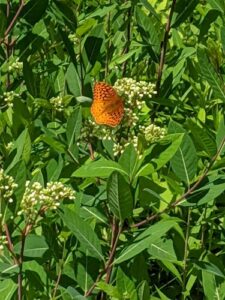Just watching the butterflies flutter by on a hot summer day is a meditation.
Around the flowers beginning to bloom in the hot July heat, the faint buzzing of bees and the fluttering wings of butterflies are summer staples. However, these sights and sounds are growing less common each year due to human-created threats. Climate change, habitat loss, and pesticides are responsible for the decreasing presence of native pollinators including bees, bumblebees, butterflies, birds, moths, and more.

Last summer at Sheep Hill, volunteers Hank Art and Gerry O’Neil planted 6100 square feet with native wildflower and grass plantings. A grant from the USDA covered a small portion of the project, which met NRCS Conservation Stewardship Program guidelines, according to WRL Assistant Director Cathy Talarico.
Native pollinators are responsible for pollinating key agricultural crops that serve both major parts of the food supply for both humans and animals. Not only are they responsible for keeping ecosystems healthy by enabling the production of fruits and berries that form the base of many food chains, but they also make it possible for us to grow and eat fruits and veggies.
The devastation to native and wild populations of insect pollinators is a major threat to our food supply. As they dwindle, farmers have taken to putting honey bee hives in their orchards and fields, however this is only partially effective. Honey bees are much less effective pollinators than native bees, so many more bees are required to ensure that all the flowers are pollinated. Honey bees also can carry pathogens that disrupt native bee populations, leading to even fewer native bees.
Native wildflowers are also in peril. Because some native flowers are not attractive to honey bees due to flower shape, lack of nectar, or a number of other factors, those native plants do not get effectively pollinated without native bees. Thus, the loss of native bees could mean the loss of certain native wildflowers.

Habitat fragmentation is one major threat to pollinator populations, so connected patches of pollinator habitat are important for their protection. A “buzzway” proposed in the fall of 2017 by the Williams College CES Environmental Planning Workshop outlines one way of reducing this habitat fragmentation across Williamstown. In this proposal, students from Williams College extensively surveyed the town and mapped out a budget and locations for a cohesive pollinator pathway spanning the entire town. The proposed pathway would range from a width of entire fields to just 3 feet wide, and could ensure that pollinators would have continuous access to habitat. A non-binding resolution passed by the town in 2017 outlined guidelines to make Williamstown a more “pollinator-friendly” community, including reducing pesticide use, increasing pollinator habitat, and mowing less frequently. Since then, efforts from organizations like Bee Friendly Williamstown have helped distribute educational materials, and the Spruces park originally designated as part of the buzzway has become a low-mow pollinator area.
Though town-wide efforts are important, individual efforts can also have a big effect. Participating in No-Mow May, as many town residents did this spring, is one way of giving our pollinator friends a wing up in their recovery from winter. Dandelions and other flowers that crop up in springtime lawns ensure a steady supply of nectar for bees to break their winter fast before other flowers emerge throughout the summer sustain the insects.

A more active management approach is to plant native wildflowers. Bee Friendly Williamstown has some excellent resources on how to support pollinators year-round by providing food and shelter.
If you would like to get started right away, here are a few native flowering plants you can encourage in your backyard that are found at Sheep Hill. Find inspiration for your own garden by talking with neighbors, visiting the pollinator garden located near the pond at the Spruces Park, and getting involved in land conservation with organizations such as Williamstown Rural Lands!
A partial list of the cultural meadow plantings at Sheep Hill:
Old field goldenrod
Smooth blue aster
Frost aster
Ohio spiderwort
Golden alexanders
Little bluestem grass
Partridge pea
Lance-leaf coreopsis
Showy tick trefoil
Purple coneflower
Round-headed bush clover
Dense blazing star
Wild lupine
Purple giant hyssop
Columbine
Common milkweed
Butterfly weed
Blue wild indigo
Small yellow wild indigo
— Researched and written by WRL Summer Intern Lydia von Schwanenfluegal
Further reading
Dravis, Stephen. “Williamstown Resolution Looks to Change Bee-Havior.” iBerkshires.com | YOUR COMMUNITY – YOUR NEWS, April 9, 2017.
Knoedler, Molly, Natasha Baranow, and Kathryn Dix. Rep. Pollinator Protection in Williamstown, MA, 2017.
McAfee, Alison. “The Problem with Honey Bees.” Scientific American. Scientific American, November 4, 2020.
“Nesting Resources.” Xerces Society. Accessed July 5, 2022.
“Pollinator Conservation Program.” Xerces Society. Accessed July 5, 2022.
